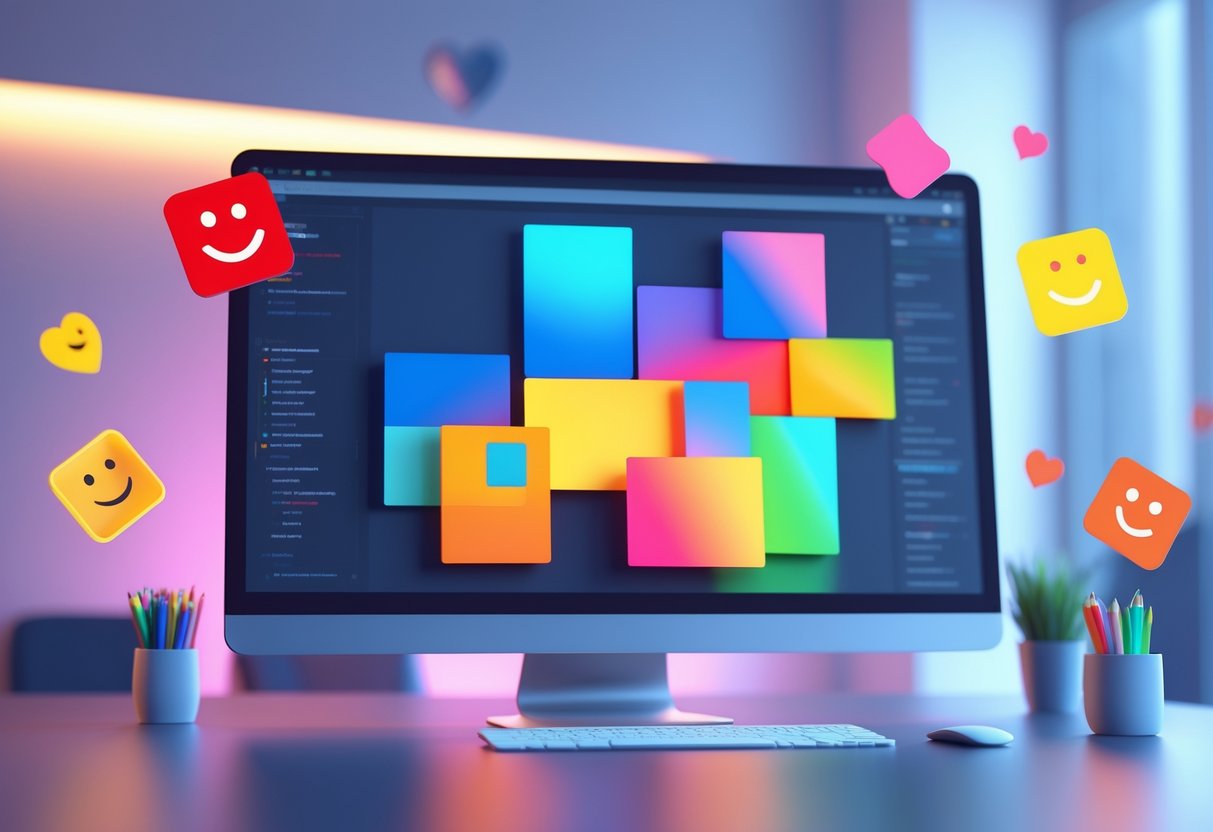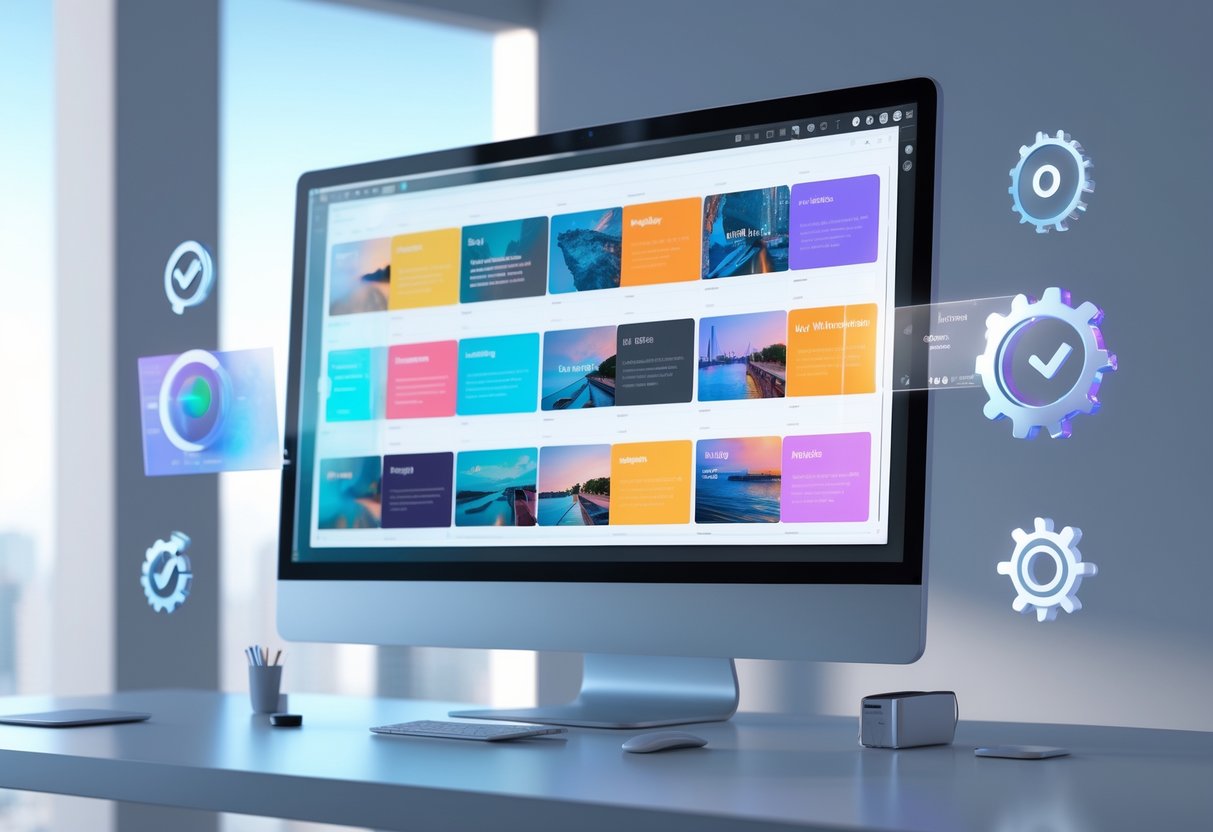Thumbnail Optimisation: Boost Clicks & Channel Growth
Updated On: October 23, 2025 by Aaron Connolly
Why Thumbnail Optimisation Matters
Thumbnails give your content its first impression. They can boost click-through rates by as much as 154%.
They shape how many people actually watch your videos and play a key part in growing your audience on YouTube, Twitch, and beyond.
Impact on Click-Through Rate
Click-through rate, or CTR, shows how often people click your thumbnail when it appears. If your CTR is low, your video might just disappear into the endless feed.
Research says optimised thumbnails can increase CTR by 90% compared to generic ones. Your thumbnail fights for attention against dozens of other videos.
Key factors that improve CTR:
- High-contrast colours that pop
- Text that’s clear and short (3-5 words tops)
- Faces showing emotion
- Simple, bold images
Try out different thumbnail designs to see what your viewers respond to. YouTube Analytics tracks your CTR, and other platforms have similar tools.
A “good” CTR depends on your gaming niche but usually sits between 4-10%. Esports videos often do better when the thumbnail features well-known players or crazy in-game moments.
Role in Audience Engagement
Thumbnails do more than just drive clicks—they shape how much people actually engage with your content. If your thumbnail matches your video, viewers stick around longer and interact more.
Your brain processes visuals about 60,000 times faster than text. So thumbnails set instant expectations for what your video’s about and how good it is.
Engagement benefits include:
- Higher watch time
- More comments and likes
- More people subscribing
- Better chances with the algorithm
Gamers love thumbnails with real reactions, epic highlights, or tournament action. Don’t use misleading images—if your video doesn’t deliver what the thumbnail promises, viewers won’t stick around.
The best thumbnails create a “curiosity gap.” They show just enough to get people interested, but not so much that there’s nothing left to discover.
Influence on Channel Growth
If you want your channel to grow, you need solid thumbnails across all your videos. Every great thumbnail acts as a mini-ad for your whole channel.
Consistent thumbnails help build your brand identity. When you use the same colours, fonts, and style, viewers start to recognise your videos before they even read the title.
Growth factors influenced by thumbnails:
- Better search visibility and more suggested video spots
- More cross-video discovery when people browse your channel
- Stronger brand recognition in crowded gaming spaces
- More partnership and sponsorship chances
Gaming channels that keep their thumbnails consistent hold onto 23% more subscribers. Your thumbnails should show off your quality and expertise.
We’ve seen channels that use professionally designed thumbnails grow 40% faster than those that just use basic screenshots. Investing in how your channel looks sends a message of credibility to both viewers and potential sponsors.
Key Elements of Effective Thumbnails
If you want your thumbnails to work, you need to balance eye-catching visuals with practical design. The best ones grab attention fast with strong images, easy-to-read text, and smart use of colour.
Visual Impact Principles
Your thumbnail has just a second or two to get noticed. Since people process images way faster than words, your picture needs to do the heavy lifting.
Show faces and emotions whenever you can. Thumbnails with expressive faces almost always beat out abstract designs.
Close-ups work better than wide shots. They just do.
Leave some mystery. Your thumbnail should tease what’s inside the video, not spell everything out. Think of it more like a movie poster than a summary.
Use the rule of thirds. Put key elements along imaginary grid lines, not right in the middle. It just looks better.
Check for mobile readability. Most people see thumbnails on their phones first. Shrink your design down before you finish it—if it looks good small, you’re on the right track.
Readable Text Techniques
Keep your text short and punchy. Stick to 3-5 words.
Pick bold, thick fonts that stand out against your background. Sans-serif fonts like Arial or Impact are usually best.
Add outlines or drop shadows to your text. White letters with a black outline work on almost any background.
Make sure your text is big enough for mobile. If you can’t read it on your phone, it’s too small.
Place the most important words where people’s eyes go first—usually the top third of the image.
Effective Use of Colour
Go for high-contrast colours that help your thumbnail jump out. Use combos that pop, not ones that blend together.
Bright, saturated colours usually win over muted tones. Reds, blues, and yellows catch the eye more than pastels or greys.
Think about the background. Most platforms use white or dark themes. Pick colours that stand out against both.
Tap into colour psychology. Red feels urgent, blue seems trustworthy, yellow grabs attention. Match your colours to the mood of your video.
Stick with your brand colours but stay flexible. Build a palette that fits your style but can adapt to different topics.
Design Psychology for Thumbnails
People make snap decisions about thumbnails in just 75 milliseconds. That’s not much time, so understanding what makes people click is huge.
The best thumbnails use curiosity gaps, spark emotions, and take advantage of our natural draw to human faces.
Curiosity Gap Strategies
The curiosity gap is all about what viewers know versus what they want to know. Your thumbnail should tease something valuable but not spill all the details.
Thumbnails that create a sense of mystery get 26% more clicks. Our brains hate not knowing, so we click to find out.
Ways to create a curiosity gap:
- Show just part of a result
- Use a “before” shot but not the “after”
- Highlight something weird or unexpected
- Ask a visual question that begs for an answer
For esports, you could show a player’s shocked face without revealing what happened. Or maybe an odd scoreline that makes people wonder how things went down.
Balance is everything. Too little intrigue and people scroll past. Too much and they think it’s clickbait.
Psychological Triggers
Certain emotions just work better than others. Data from top videos shows surprise (26.95%) and happiness (26.65%) lead the pack.
These high-energy emotions grab attention and promise a fun watch.
Best triggers:
- Surprised faces or wild moments
- Excitement and celebration
- Tension and anticipation
- Achievement and victory
Negative emotions like sadness or disgust barely show up in high-performing thumbnails. They usually push viewers away.
Colour choices matter too. Using bold, complementary colours can boost CTR by up to 42% compared to flat, dull designs. Contrasts really do make images pop.
Using Human Faces
Our brains spot faces in a flash—within 50-75 milliseconds, actually. The Fusiform Face Area lights up and pulls our attention straight to the thumbnail.
Thumbnails with faces get 20% more clicks on average. That’s a big deal.
Best practices for faces:
- Show clear, strong emotions
- Make sure faces are big enough to see on mobile
- Use direct eye contact if you can
- Stick to single subjects instead of groups
Studies on vlogs found that focusing on one person led to 37.4% more views than group shots. Simpler scenes just work better.
Let the face fill most of the thumbnail. Exaggerated expressions help, especially when viewers are watching on tiny screens.
Brand Consistency and Recognition

If you want people to recognise and trust your content, you need consistent branding in your thumbnails. Using the same design elements makes your videos stand out and look professional.
Maintaining Brand Identity
Your brand identity starts with picking the right colours, fonts, and visual styles that fit your channel’s vibe.
A lot of top creators use the same colour palette for every thumbnail. That way, even at a glance, viewers know it’s your video.
Colour consistency is super important, especially on mobile. Choose two or three main colours that work well together and stick with them. Gaming channels often go for bold colours like electric blue and orange, while educational ones might use softer tones.
Keep your typography the same. Use one font family for all your thumbnails, just changing the size or weight when needed. Bold, sans-serif fonts are usually easiest to read on small screens.
Make a brand style guide with your colour codes, preferred fonts, and logo placement rules. This helps you stay consistent even when you’re in a rush or working with others.
Consistent Thumbnail Design
Templates save time and keep your look consistent. Build three or four thumbnail templates for different types of videos—like tutorials, reviews, or reaction videos.
Stick to the same layout. If your logo sits in the bottom-right corner, keep it there on every thumbnail. Viewers will know where to look.
Keep your visual hierarchy steady. Use similar text sizes, spacing, and effects from one thumbnail to the next.
A lot of creators add branded overlays or frames to every thumbnail. Subtle gradients, borders, or patterns can become part of your channel’s identity.
Optimising for YouTube Thumbnails
YouTube has its own technical rules, and it gives you powerful analytics tools to track how your thumbnails perform. Knowing the guidelines and using CTR data helps you make better choices.
Platform Guidelines and Best Practices
YouTube wants thumbnails to be 1280×720 pixels with a 16:9 aspect ratio. The file can’t be bigger than 2MB, and you can use JPG, GIF, or PNG formats.
JPG works best for photos, while PNG is better for graphics with text. This keeps the file small but still looking sharp.
Technical Requirements:
- 1280×720 pixels minimum
- 16:9 aspect ratio
- Under 2MB file size
- JPG, GIF, or PNG format
YouTube shows thumbnails at different sizes depending on the device. On mobile, they’re much smaller, so make sure your text is still readable at 320 pixels wide.
YouTube puts a timestamp in the bottom-right corner, so avoid putting anything important there.
You’ll need to verify your channel by phone before you can upload custom thumbnails. New channels can’t use custom images until they finish this step.
Leveraging YouTube Analytics
YouTube Analytics gives you loads of data about your thumbnails, especially CTR. You’ll find this info in YouTube Studio under the “Reach” tab.
CTR tells you what percentage of people clicked after seeing your thumbnail. The industry average is 2-10%, but honestly, it’s better to compare your own videos against each other.
Metrics to watch:
- Impressions: How many times your thumbnail was shown
- CTR: The click-through rate
- Traffic sources: Where your viewers came from
The “Test & Compare” feature lets you A/B test different thumbnails for the same video. Upload a couple of options and YouTube will split the traffic for at least 14 days.
If you have a high CTR but low watch time, your thumbnail might be misleading. YouTube’s algorithm cares more about watch time than clicks, so make sure your thumbnail matches your video.
Look at your top-performing videos to spot patterns in colour, layout, and text. Use that info to shape your next thumbnails—let your real data guide you, not just guesses.
Data-Driven Thumbnail Optimisation

If you want to optimise thumbnails, you’ve got to try different versions and actually see which ones get clicks. We look at numbers like click-through rates and impressions to figure out what’s working.
A/B Testing Methods
A/B testing lets you put two thumbnail versions head-to-head. You make two designs and show them to similar groups of viewers.
Set up your test properly:
- Change just one thing at a time—maybe colour, text, or the main image.
- Let the test run at least 48-72 hours.
- Make sure you get enough impressions so your data means something.
Common elements to test:
- Colours: Bright backgrounds vs dark ones.
- Text: With overlay text or without.
- Faces: Close-up expressions or full body shots.
- Composition: Centre vs rule-of-thirds.
Most platforms, like YouTube Creator Studio, can show different thumbnails to random viewers automatically. You just track which version gets more clicks after the same amount of exposure.
The thumbnail with more clicks wins and becomes your main one.
Analysing Performance Metrics
We focus on three numbers to judge if a thumbnail’s actually good. These metrics show if your designs work in real life.
Click-through rate (CTR) is king. It tells you how many people clicked after seeing your thumbnail. Depending on what you make, a good CTR usually sits between 4-10%.
Impressions just tell you how often your thumbnail popped up in feeds. If you get lots of impressions but a low CTR, people saw it but didn’t care to click.
Engagement rate shows what happens after the click. If viewers bounce right away, maybe your thumbnail promised something your video didn’t deliver.
Check these stats every week in your analytics dashboard. Try to spot patterns—do certain colours or styles always do better for you?
Compare your CTR with other creators in your niche. That gives you a realistic target to aim for.
Thumbnail Typography and Readability

Typography can make or break your thumbnail. The right fonts and strong contrast help people read your text instantly, even on tiny screens.
Choosing Fonts and Sizes
Bold, sans-serif fonts just work for YouTube thumbnails. They stay crisp and readable, even when shrunk down.
Fonts like Arial, Helvetica, and Impact are popular for a reason. Their thick strokes and clear shapes hold up at small sizes.
Keep your text big—at least 24-30 pixels tall in a 1280×720 thumbnail. If you can’t read your text when the image is tiny, it’s too small.
Try not to use more than two font styles. Too many fonts just look messy and amateurish.
Script fonts or decorative typefaces? Skip them. They turn unreadable fast when thumbnails shrink in search results.
A lot of creators stick to the same font on every thumbnail. It helps people recognise your videos instantly.
Contrasting Text and Backgrounds
You need strong contrast between text and background to keep things readable. Light text on dark backgrounds or the other way around usually works best.
Use outlines, drop shadows, or background boxes to make your text pop. A white outline around coloured text can fix readability problems in seconds.
Try putting a semi-transparent dark rectangle behind your text. It creates contrast but keeps the background visible.
Don’t put text over busy parts of your image. Find clean areas where your message won’t get lost.
Test your contrast by converting your thumbnail to grayscale. If the text fades away, you need more contrast.
Complementary colours from opposite sides of the colour wheel can help. Red text on a green background, for example, jumps out right away.
Applying Colour Psychology

The right colours grab attention and trigger emotions that make people click. Using contrast and breaking patterns helps your content stand out in a crowded feed.
Selecting High-Impact Colours
Red is still the most powerful colour for YouTube thumbnails. It brings urgency and excitement. Studies even show red thumbnails can bump up click-through rates by 20% compared to neutral tones.
Orange and yellow work too. They signal energy and positivity—great for gaming, tutorials, and entertainment.
High-performing colour combos:
| Primary Colour | Accent Colour | Best For |
|---|---|---|
| Bright red | White text | Gaming, reaction videos |
| Electric blue | Yellow highlights | Tech reviews, tutorials |
| Orange | Black text | Entertainment, vlogs |
| Purple | Green accents | Creative content |
Blue builds trust and looks professional, so it’s perfect for educational stuff. Just don’t go overboard, or it’ll blend into YouTube’s own interface.
Green gives off a fresh, growing vibe, but use it carefully. Some creators avoid green since it can disappear among other thumbnails.
Pattern Interruption Techniques
Pattern interruption means you break the visual routine to grab attention. Most thumbnails follow the same old layouts, so shaking things up helps yours stand out.
Ways to interrupt patterns:
- Use unusual angles—tilt text or images a bit instead of keeping everything straight.
- Try asymmetrical layouts. Put key stuff off-centre for a change.
- Mix smooth graphics with rough textures.
- Make one element way bigger or smaller than the rest.
Bright colours on dark backgrounds interrupt the pattern best. For example, a yellow face on black pulls the eye away from everything else.
Break the “rule of thirds” sometimes. Put important stuff where people don’t expect it to create tension and curiosity.
Human faces are natural interrupters, especially when they show big emotions. A surprised or excited face can break up the monotony and make people curious.
Mobile and Multi-Device Considerations

Most people find your content on their phones, where thumbnails shrink and details vanish. Thumbnails that work on every screen size keep more viewers around.
Optimising for Small Screens
Your thumbnail has to catch the eye in a space as small as your thumb. On mobile, thumbnails are often just 168×94 pixels on YouTube.
Text is the biggest challenge. Keep it to three words max, and use bold, high-contrast fonts that don’t blur out.
Faces work wonders on mobile. Close-ups with clear emotions still read well, even when tiny.
Simplify your design. Avoid cluttered backgrounds or too many competing elements. One clear focal point beats a busy layout.
Test your contrast. What’s sharp on your monitor might blur together on a phone. Bright colours on dark backgrounds (or the reverse) help.
For gaming, a single character portrait usually beats a busy screenshot. The character’s face tells the story instantly.
Ensuring Clarity Across Devices
Every platform crops thumbnails differently, so your design has to survive in all aspect ratios.
Set up a safe zone. Keep important stuff in the centre third so cropping doesn’t chop off key details.
Check how your thumbnail looks with different brightness settings. Phones often auto-adjust, so your image needs to be visible in any light.
Keep file sizes reasonable. Not everyone has fast internet, but you still want decent quality.
Test on phones, tablets, and desktops before publishing. What looks great on one device might flop on another.
Esports content does well with bold team logos and player headshots. They stay recognisable everywhere.
Embracing AI and Design Tools

Modern AI tools and design platforms have changed the game for thumbnail creation. Now, you don’t need advanced design skills to get pro-level results. These tools analyse what works and automate the process while keeping your branding consistent.
AI-Powered Thumbnail Creation
AI thumbnail generators crank out multiple variations in seconds, not hours. They study millions of top thumbnails to figure out what gets clicks in your niche.
Key benefits:
- Automated A/B test variations
- Optimisation for each platform
- Consistent branding
- Data-driven design choices
Tools like Taja AI and Thumbly use machine learning to create thumbnails that match your audience’s taste. They can switch up colour schemes, text, and layouts for you.
The tech checks out what works in your category, then applies those patterns to your images and branding.
Still, you need to keep an eye on things. AI can’t replace your creative direction or brand sense.
Template and Generator Options
Design platforms offer thumbnail templates fine-tuned for different platforms and content types. You get pro layouts that you can tweak with your own images and text.
Template perks:
- Brand consistency
- Text sized for mobile
- Proven layouts
- Fast customisation
Canva, Figma, and Adobe Express all have big template libraries. Drag-and-drop tools make customising easy.
Some generators even handle text sizing, colour suggestions, and image filters. A few plug right into your content management system for smoother workflows.
Pick templates that fit your content style and what your viewers expect. Gaming thumbnails need a different vibe than educational ones.
Improving Audience Engagement

A great thumbnail can boost your engagement by up to 90% and increase views by 154%. The trick is to spark curiosity and connect with your audience using smart visuals.
Driving Viewer Curiosity
If you want to spark curiosity, you’ve got to balance what you show and what you hide. Think like a storyteller—use visuals that ask questions instead of giving away the whole answer.
Emotional triggers work wonders. Faces showing surprise, excitement, or concern make people wonder what’s going on. Thumbnails with expressive faces almost always outperform those without.
Text overlays should tease, not spoil. Instead of “How to Win Every Match,” try something like “The Secret Pro Players Don’t Want You to Know.” That little mystery pulls people in.
Use visual contrast to stand out. Bright colours against YouTube’s white background make people pause their scroll. High-contrast elements buy you a few extra seconds of attention.
Boosting Engagement Rate
Your engagement rate depends on setting the right expectations with your thumbnail. Misleading designs may get clicks, but they’ll wreck your retention and hurt you in the long run.
Consistency across your channel builds trust. When viewers spot your style, they’re more likely to click because they know what they’ll get. Stick with similar colours, fonts, and layouts.
Mobile optimisation is a must. With most views coming from phones, always check that your thumbnails stay readable and clear at small sizes. Simple, bold designs beat clutter every time.
Keep an eye on your click-through rates in YouTube Analytics. Test different styles, and when something works, use it again. This way, your thumbnails keep getting better at engaging your audience over time.
Frequently Asked Questions

When you’re optimising thumbnails, you’ll probably run into a few technical headaches—loading speed, dimensions, compression, automation tools, file formats, and even SEO. These questions dig into the real-world issues you’ll face as you try to boost performance.
How can I improve the loading speed of thumbnails on my website?
Try lazy loading so thumbnails only appear when users actually scroll to them. On image-heavy pages, this can chop initial load times by 30-50%.
Serve up images in modern formats like WebP or AVIF. They usually compress 25-35% better than old-school JPEGs.
A Content Delivery Network (CDN) can help too. By serving thumbnails from servers closer to your visitors, you’ll cut down on lag—Cloudflare, AWS CloudFront, and Fastly are solid picks.
Use responsive images with the srcset attribute. That way, mobile users aren’t stuck downloading giant files, but desktop users still get sharp images.
What are the best dimensions for a thumbnail to ensure it looks good on all devices?
For most platforms, 1200×630 pixels (that’s a 1.91:1 ratio) works great, especially for sharing on Facebook, Twitter, or LinkedIn.
If you’re making YouTube content, go with 1280×720 pixels (16:9 ratio), and keep the file under 2MB. That’ll keep things crisp everywhere.
Create thumbnails at double the resolution and scale them down. This trick makes images look extra sharp on high-DPI screens, like Retina displays, and still good on regular ones.
For Instagram and similar sites, square thumbnails at 1080×1080 pixels usually look best. Platforms keep changing, so test a few sizes and see what your audience likes.
What are some effective compression techniques for thumbnails without losing quality?
We usually reach for TinyPNG or ImageOptim—they shrink JPEG and PNG files by 60-80% and you barely notice any difference. They strip out extra metadata and tidy up colour profiles.
Set JPEG quality to somewhere between 75-85%. It’s a sweet spot for keeping images small but still looking decent.
Only use PNG if you need transparency or if there’s text layered on top. For photos, JPEGs are almost always smaller and still look fine.
WebP is a good bet too, if your audience uses modern browsers. Set up JPEG fallbacks just in case. WebP files can be 25-35% smaller than JPEGs and look just as good.
Are there any tools that can help me automate thumbnail creation and optimisation?
Canva makes thumbnail creation pretty painless with its templates and bulk options. There’s a free version, but the paid plan starts at about £10 a month.
If you’re comfortable with command-line tools, ImageMagick lets you generate thumbnails in batches and slot it right into your workflow. It’s free and handles loads of images at once.
Thumbly and similar AI tools can scan top-performing thumbnails in your niche and spit out variations for A/B testing. That’s handy if you want to experiment.
On WordPress, plugins like Smush or ShortPixel automatically compress thumbnails as you upload them. It’s a set-and-forget solution for most people.
What role does the file format play in thumbnail optimisation, and which formats are recommended?
We usually go with WebP first for modern browsers—it balances quality and compression and supports transparency, which is a plus.
JPEG is still the go-to for photos that don’t need transparency. It handles complex images with lots of colours really well and keeps file sizes low.
If your thumbnail has text, logos, or needs transparency, PNG is a solid choice, but just know the files are bigger than JPEG or WebP.
AVIF compresses even better than WebP, but not every browser supports it yet. If you use it, make sure to set up fallbacks to WebP and JPEG for everyone else.
What’s the impact of high-resolution thumbnails on SEO, and how can I balance quality with performance?
Page loading speed really matters for search rankings. If your thumbnails load slowly, you might see your search visibility take a hit.
Google cares about Core Web Vitals, and one of those is Largest Contentful Paint (LCP). Basically, if you want to hit that 2.5-second mark, your thumbnails need to be optimised.
Don’t forget to add proper alt text and use descriptive filenames for your images. That way, search engines can actually figure out what’s in your thumbnails, which can bump you up in image search results.
Try to balance quality with speed by serving different image sizes depending on the device or connection. Lazy loading helps, and progressive JPEGs can make images feel like they load faster—even if it’s just a little trick on the eyes.

